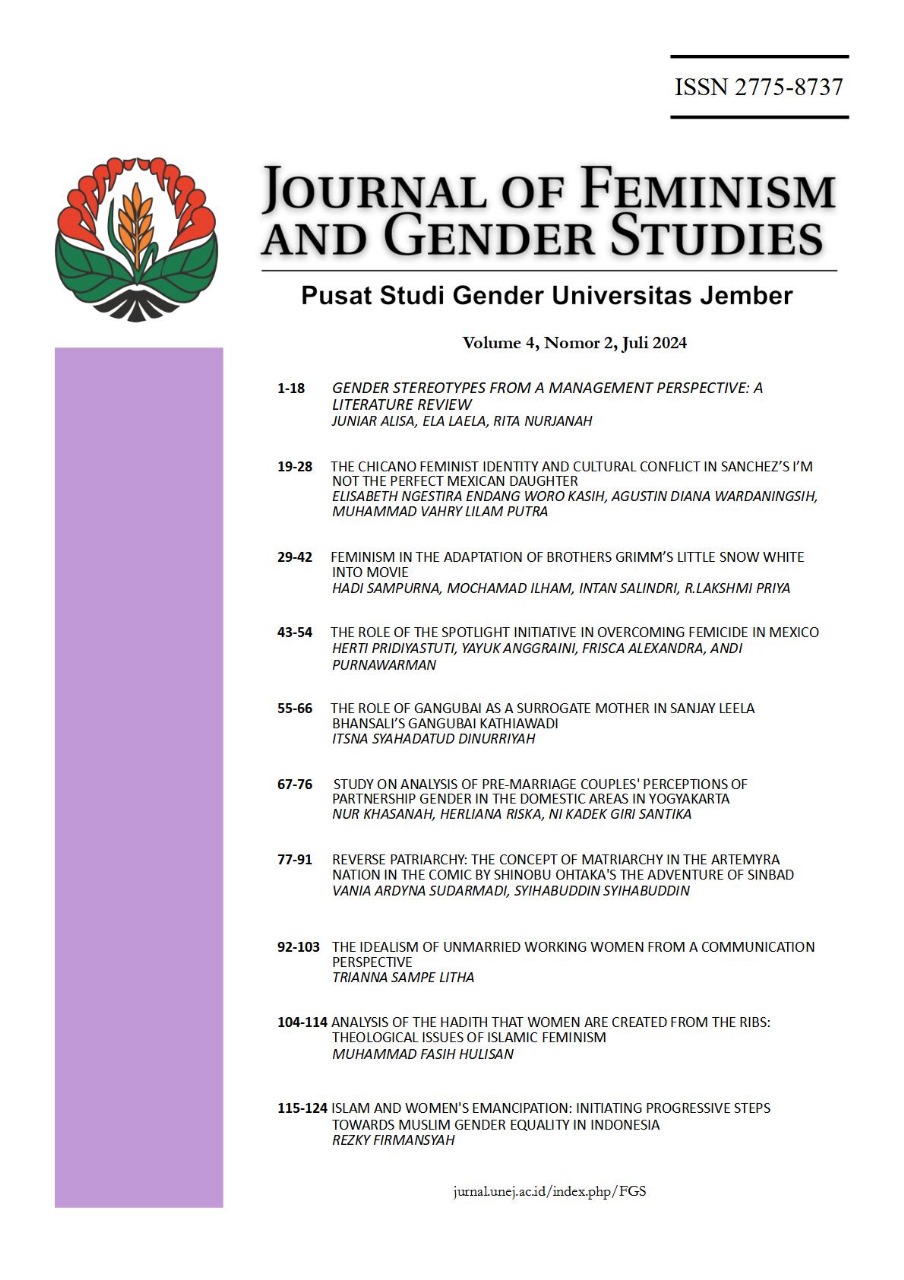Feminism In The Adaptation Of Brothers Grimm’s Little Snow White Into Movie
Abstract
The aim of this study is to identify changes in ideology on character and the plot in the adaptation of the fairy tale Little Snow White by Brothers Grimm. The research data consists of narrative texts from the fairy tale and visual scenes from the movie adaptation. The data are analyzed with comparative approach and Barthes' semiotics theory. In addition, the visual scenes are analyzied with cinematography and mise en scene approach. The findings show the changes of ideology in the fairy tale into movie adaptation. The dominant ideology of fairy tales is patriarchy, which emphasizes gender inequality, women oppression, and damsels in distress. Other than patriarchy, the fairy tale's ideology is Eurocentrism. Meanwhile, the movie adaptation depicts a variety of ideologies, namely cultural racism, feminism, radical-libertarian feminism, and androgyny; however, upon closer inspection, feminism emerges as the dominant ideology
References
Barthes, R. (1972). Mythologies. The Noonday Press.
Callaghan, K. A. (1994). Ideals of Feminine Beauty: Philosophical, Social, and Cultural Dimensions. Praeger. https://archive.org/details/idealsoffeminine0000unse/mode/2up
Creswell, J. W. (2014). Research Design: Qualitative, Quantitative, and Mixed Methods Approaches (4th ed). SAGE Publications.
Deguzman, K. (2023, April 30). What is Juxtaposition in Film? Definition and Example. Studiobinder. https://www.studiobinder.com/blog/what-is-juxtaposition-definition/
Dianiya, V. (2020). Representation of Social Class in Film (Semiotic Analysis of Roland Barthes Film Parasite). Profetik Jurnal Komunikasi, 13(2), 212–224. https://doi.org/10.14421/pjk.v13i2.1946
Giddens, A. (2006). Sociology (5th ed.). Polity Press.
Greenhill, P., Rudy, J. T., Hamer, N., & Bosc, L. (2018). The Routledge Companion to Media and Fairy-Tale Cultures (1st ed.). Routledge.
Grimm, W., Grimm, J., Zipes, J., & Dezsö, A. (Eds.). (2014). The Original Folk and Fairy Tales of the Brothers Grimm: The Complete First Edition. Princeton University Press.
Hall, R. E. (2013). The Melanin Millennium: Skin Color as 21st Century International Discourse. Springer.
Hutcheon, L., & O’Flynn, S. (2013). A Theory of Adaptation (2nd ed). Routledge.
Jha, M. R. (2016). The Global Beauty Industry: Colorism, Racism, and the National Body. Routledge.
Kenny, E., & Nichols, E. G. (2017). Beauty around the World: A Cultural Encyclopedia. ABC-CLIO.
Klarer, M. (1999). An Introduction to Literary Studies. Routledge.
Mallet, S. (2004). Understanding Home: A Critical Review of the Literature. The Sociological Review, 52(1), 62–89.
Meaning of a Damsel in Distress. (2023). In Cambridge Dictionary. https://dictionary.cambridge.org/dictionary/english/damsel-in-distress
Moore, J. H. (2007). Encyclopedia of Race And Racism (1st ed., Vol. 3). Macmillan Library Reference.
Murai, M., & Cardi, L. (2020). Re-Orienting the Fairy Tale: Contemporary Adaptations across Cultures. Wayne State University Press.
Narti, S., & Sari, S. (2022). Representation of Gender Discrimination and Patriarchal Culture in Movie of Mulan 2020 (Roland Barthes Semiotics Analysis). IHSA Institute, 11(3), 1813–1820.
O’Connor, K. (2010). Gender and Women′s Leadership: A Reference Handbook (1st ed.). SAGE Publications.
Petrie, D. W., & Boggs, J. M. (2012). The Art of Watching Films (8th ed). McGraw-Hill Companies, Inc.
Rubin, G. (1975). Toward an Antrophology of Women. Monthly Review Press.
Sanders, R. (Director). (2012). Snow White and the Huntsman [Fantasy]. Universal Pictures.
Scruton, R. (2011). Beauty: A Very Short Introduction. Oxford University Press.
Shohat, E., & Stam, R. (2014). Unthinking Eurocentrism: Multiculturalism and the Media (2nd edition). Routledge.
Skard, T. (2014). Women of Power: Half a Century of Female Presidents and Prime Ministers Worldwide. Policy Press.
Snyder, M. H. (2011). Analyzing Literature to Film Adaptations: A Novelist’s Exploration and Guide. Continuum.
Teverson, A. (2013). Fairy Tale. Routledge.
Thomas, R. M. (2001). Recent Theories of Human Development (1st ed.). SAGE Publications.
Tong, R. (2009). Feminist Thought: A More Comprehensive Introduction (3rd ed.). Westview.
Walby, S. (1990). Theorizing Patriarchy (1st ed.). John Wiley & Sons.
Weindling, P. (1993). Health, Race and German Politics between National Unification and Nazism, 1870–1945. Cambridge University Press.
Winchester, C. (2021). ‘Whistle While You Work’: A Comparative Study of Gender Representation in ‘Little Snow White’ and Snow White and the Seven Dwarfs. ANU Undergraduate Research Journal, 11(1), 22–28.
Wolf, V. (2002). The Beauty Myth: How Images of Beauty are Used Against Women. Harper Perennial.
Zipes, J. (2011). The Enchanted Screen: The Unknown History of Fairy-Tale Films (1. publ). Routledge.

This work is licensed under a Creative Commons Attribution-ShareAlike 4.0 International License.











